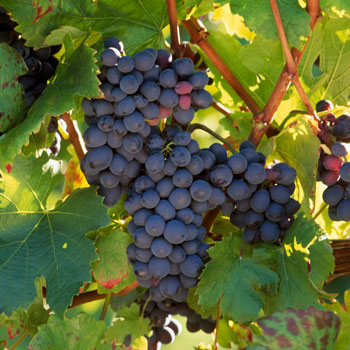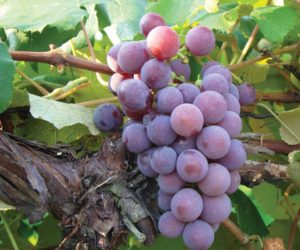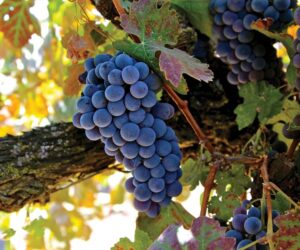 Like Garnacha (Grenache) is to Spain, Pinotage is to South Africa. In this issue’s installment of “Varietal Focus,” we travel south — way south — past the equator, over deserts and through jungles to the southernmost tip of the continent of Africa, to the country of South Africa, where the red grape Pinotage was born.
Like Garnacha (Grenache) is to Spain, Pinotage is to South Africa. In this issue’s installment of “Varietal Focus,” we travel south — way south — past the equator, over deserts and through jungles to the southernmost tip of the continent of Africa, to the country of South Africa, where the red grape Pinotage was born.
Pinotage History
Pinotage was bred as a cross between Pinot Noir and Cinsault in 1925 by viticulture professor Abraham Izak Perold at Stellenbosch University in South Africa. Pinotage is not a hybrid as some may assume. A hybrid is a cross between two species, such as the hybrid Chardonel, (Seyval X Chardonnay), whereas the breeding of interspecies grapes is referred to as a cross (v. vinifera x v. vinifera). Four seeds from that original Pinot Noir/Cinsault cross were planted at Stellenbosch, however, the block went untended after Dr. Perold left the university. The block was destined for removal, but the four seedlings were rescued and moved to Elsinburg Agricultural College by CJ Theron, Perold’s successor. Perold stayed in contact with his former colleagues, and around 1937 he and Theron identified the best of the four vines and christened the variety with the name Pinotage. The first wines from Pinotage were later made in 1941.
South Africa has a long and storied wine industry history, which dates back to 1659. It was not long after the colonization by the Dutch that the fledgling colony began exporting dessert wines to Europe. These wines were so coveted they commanded higher prices than any of the other classic dessert wines of Europe. The wines of the time enjoyed tariff-free distribution in Europe until 1861 when Great Britain, then the colonial power in the Cape, abolished the tariff relief and the exported wine from South Africa then had to compete on the same terms as those from France, Portugal and Italy — regions that were much nearer to the target markets. Shipping costs made exporting even more difficult, and 25 years later the devastation of phylloxera left its final mark on the South African wine industry. The wine scene there crumbled, until the KWV (Kooperatieve Wijnbowers Vereniging), a cooperative winegrowers association, was established to take control of the industry. They specified what could be planted where, how much could be produced and the price structure. For many years, in the early twentieth century, the only wines exported were those from the KWV. The table wines were based on grapes that were not popular as varietals: Chenin Blanc (known as Steen), Cinsault and Pinotage. The industry struggled under the boycotts in protest of South Africa’s system when apartheid took hold. Following the political settlement of the early 1990s and the end of apartheid, the power of the KWV also dwindled, and small wine producers began to diversify. Winemakers traveled to South Africa and plantings of Chardonnay, Gewürztraminer, Pinot Noir and Merlot sprung up. Pinotage, however, decreased in popularity and plantings as winemakers felt that the emerging market should compete on a global level by producing more well-known varieties.
Pinotage Currently
Currently, Pinotage is 8th on the list of rankings of total wine grape plantings in South Africa. The first commercial plantings were in 1943, near Sir Lowry’s Pass, just east and south of Cape Town. The Cape, as it is known, boasts many wine regions over a range of varying microclimates, which range from maritime to hot. Pinotage is currently cultivated in all of those regions, with the most plantings in Malmesbury (4,250 acres), Stellenbosch (3,400 acres), and Paarl (2,500 acres). Worcester, the Olifants River region and Robertson comprise a combined acreage of about 2,500 acres. In the other regions where Pinotage is grown, plantings are less than 250 acres each. South Africa is well suited for rich red wines, but the Cape grows a majority of white grapes due to consumer preference.
While Pinotage enjoys fame as South Africa’s grape, it contributes just a small amount to the total tons crushed. According to the South African Wine Industry Statistics (SAWIS) 64,508 total tons of Pinotage was crushed in 2009, which is just 4.8% of the total tons crushed that year. In contrast, the total red crush in 2009 was 449,027 tons or just 33.8% of the total fruit crushed. Outside of South Africa, there are Pinotage plantings in Zimbabwe, New Zealand and the United States, specifically California. In contrast to South Africa, California crushed 105 tons in 2010, up from 82 tons in 2009. When looking at the distribution of the variety across California, it is grown in the cool regions of the north coast as well as the warmer, drier southern portion of the state, where warmer daytime temperatures are mitigated by the maritime influence, similar to South Africa.
There are those winemakers who believe, and I am also one of them, that the best wines of any variety are created in the vineyard. Proponents of Pinotage argue this as well, however, the grape can tolerate both cold and warm temperatures, a variety of soil types and can be drought resistant. That said, the Pinotage Association of South Africa says that the best vines are “old bush” vines (30 to 40 years old) that grow under dryland conditions on medium-deep hilly slopes with soil that has a good water retention capacity and a cooler southeast or southwest aspect or a warmer north or northeast aspect. Modern vineyard practices to accommodate for mechanization have resulted in some of best recent wines, but this is the result of careful viticulture in matching the right clone of Pinotage, with a well-suited rootstock for the soil it is grown on.
Enology of Pinotage
Pinotage can be made into a variety of styles. Cooler fermentations (71 to 75 °F/22 to 24 °C) result in more estery components, a style that is used for wines that will be released relatively young, which are often referred to in South Africa as “lifestyle” wines. These cooler styles also take advantage of some whole berries in the fermentation medium (this is achieved by widening the space between the rollers on the crusher destemmer).
Warmer fermentations are reserved for the best and boldest reds, where fermentation temperatures push upwards to 90 °F (32 °C), and most of the berries are crushed, allowing for maximum extraction of tannins and color. One winemaker I consulted said that the optimal temperature for high sugar content (25 °Brix and above) is 27 to 30 °C (81 to 86 °F). This helps prevent the solvent-like characters that Pinotage can easily develop. Pump-overs or punch-downs are needed early in the fermentation to help mitigate temperature and prevent the possibility of a stuck fermentation. Fermentations are commonly done in open top fermenters and cap management is done either by classical pump overs, or by manual or semi-manual punch downs.
In either style of Pinotage, pressing off the skins is recommended prior to the wines going dry (2 to 8 °Brix) keeping the press fractions separate for blending back later. Yeast strains need to be ethanol tolerant and should not have the propensity to form any acetone-like characters, such as Lallemand D80 or BM4X4, as well as Anchors NT. Most wines will require tartaric acid supplementation since approximately 30–60% of the total acid in the fruit at harvest consists of malic acid, which will be consumed in the malolactic fermentation (MLF). The final preferred pH is 3.60 with an acidity of around 6 g/L (it should be fermented dry (less than 2 g/L of sugar). Some winemakers may use enzymes to increase extraction from the skins, however, if you have had no personal experience with the grape, try a couple of vintages and fermentation temperature regimens before experimenting with enzymes. Some winemakers may also use oak chips or tannin prior to fermentation to aid in color extraction. During aging, winemakers usually age in French oak barrels for one to two years.
Pinotage is well promoted these days in South Africa by the Pinotage Association of South Africa, who developed a Pinotage aroma wheel, based on the principle of the Wine Aroma Wheel, developed by Professor Ann Noble UC-Davis in the mid 1990s. It is interesting to read the wheel as it presents descriptors of banana and mango, (quite unusual for a red wine) to classic dark red fruit characters typical of red wine. You can download a copy of the Pinotage wheel online at: www.pinotage.co.za/assets/images/aroma_wheel_english.gif. Wines from cooler locations often have a fruity cherry or blackberry character, while plum and banana characters distinguishes wines from warmer regions. Pinotage wines can sometimes display an acetone-like character, which is considered a fault by some and a natural characteristic by others.
Pinotage is also available as a wine kit from several different companies if you can’t get any grapes or juice, which gives you the option of trying your hand at making wine with this diverse South African grape that is becoming more and more popular.
Pinotage Recipe
(yield: 5 gal/19 L)
Ingredients
• 125 pounds (57 kg) fresh Pinotage fruit
• Distilled water
• 10% potassium metabisulfite (KMBS) solution. Weigh 10 grams of KMBS, dissolve into about 50 milliliters (mL) of distilled water. When completely dissolved, make up to 100 mL total with distilled water.
• 5 grams Lallemand D80 yeast or BM4X4 from Lallemand, Scottlabs.
• 5 grams Di-ammonium Phosphate (DAP)
• 5 grams Go-Ferm
• 5 grams Fermaid K (or equivalent yeast nutrient)
• Malolactic fermentation starter culture (CHR Hansen or Equivilent)
Other equipment or needs specific to this recipe
• (1) 15-gallon (57-L) food-grade plastic bucket for fermentation.
• 5-gallon (19-L) carboy, one or two 1-gallon (3.8 L) jugs
• Racking hoses
• Crush equipment, destemmer/crusher
• Wine press
• Inert Gas – Nitrogen, Argon or Carbon Dioxide
• Thermometer capable of measuring between 40-110 °F (4-43 °C) in one degree increments.
• Pipettes with the ability to add in increments of 1 milliliter
• Clinitest® tablets to measure residual sugar at the completion of fermentation.
• Tartaric acid — addition rate is based on acid testing results.
• Ability to maintain a fermentation temperature of 81–86 °F (27–32 °C).
TIP: Freezer space and ice blocks — prior to harvest, buy several one-liter bottles of water, drink the water, and replace with water and freeze. This will be your refrigeration system for peak fermentation. If you have other means to keep things cool, of course use that.
TIP: you may have a need to keep it warm with a heat generating source.
Step by Step
1. Clean and sanitize all your winemaking tools, supplies and equipment.
2. Crush and de-stem the grapes. Transfer the must to your fermenter.
3. During the transfer, add 15 milliliters of 10% KMBS solution (This addition is the equivalent of 50 ppm SO2). Mix well.
4. Take a sample to test for Brix, acidity and pH. Keep the results handy.
5. Layer the headspace with inert gas and keep covered. Keep in a cool place overnight.
6. The next day suspend the Fermaid K in a little distilled water (usually ~ 20 mL). Add to must or juice and mix well.
7. Go back to those lab results you took yesterday. Typical Brix for this style is 24–25 °B. Typical acid levels will be about 6 g/L. Adjust as necessary using tartaric acid. If the acid is higher than 0.70%, don’t panic, this recipe calls for a minimum final acidity of 0.50%. Higher acid won’t hurt here.
7. Prepare yeast: Heat about 50 mL distilled water to 108 °F (42 °C). Mix the Go-Ferm into the water to make a suspension. Take the temperature. Pitch the yeast when the suspension is 104 °F (40 °C). Sprinkle the yeast on the surface and gently mix so that no clumps exist. Let sit for 15 minutes undisturbed. Measure the temperature of the yeast suspension. Measure the temperature of the must. You do not want to add the yeast to your cool juice if the temperature of the yeast and the must temperature difference exceeds 15 °F (8 °C). To avoid temperature shock, you should acclimate your yeast by taking about 10 mL of the must juice and adding it to the yeast suspension. Wait 15 minutes and measure the temperature again. Do this until you are within the specified temperature range. Do not let the yeast sit in the original water suspension for longer than 20 minutes.
8. When the yeast is ready, add it to the fermenter and mix.
9. You should see signs of fermentation within about one to two days. This will appear as some foaming on the must surface and it will appear that the berries are rising out of the medium. This is referred to as the “cap rise.”
You need have on hand the ability to push the grapes back into the juice to promote color, and tannin extraction. This is called “punching down” and should be done three times per day.
10. Monitor the Brix and temperature twice daily during peak fermentation (10–21 °Brix). Morning and evening is best and more often if the temperature shows any indication of exceeding 86 °F (30 °C). Place your frozen water bottles in the fermentation. Mix the must. Wait 15 minutes, mix and check the temperature again. Do this as often as it takes to keep the temperature between 81–86 °F. Do not cool to less than 81 °F (27 °C).
11. At about 19 °Brix, sprinkle in the DAP and punchdown.
12. When the Brix reaches 4 °Brix (about 4–5 days), transfer the must to your press, and press the cake dry. Keep the free run wine separate from the press portion for now. Be sure to label your vessels to keep the press portion separate!
13. Transfer the wine to your carboys or 1-gallon (3.8 L) jugs. Your press fraction may only be a gallon or two. Make sure you do not have any headspace. Place an airlock on the vessel(s). Label the vessels.
14. Inoculate with your malolactic (ML) bacteria. Check the manufacturer’s instruction on how to prepare and inoculate. Cover the tops with a breather to allow CO2 to escape.
15. Monitor the ML fermentation using a thin layer chromatography assay available from most home winemaking supply stores. Follow the instructions included in the kit.
16. When the ML is complete, measure the residual sugar using the Clinitest®. You want the wine to be below 0.5%. Measure the TA again. If the acid is too low, make acid adjustments.
17. Add 2 mL of fresh KMBS (10%) solution per gallon of wine. This is the equivalent to ~40 ppm addition.
18. Measure the pH and titratable acidity. Most importantly you want a finished TA of about 0.60%. The pH is secondary but should be around 3.6. Add acid to adjust the TA prior to settling.
19. Place the wine in a cool place to settle and cold stablize.
20. Consider adding some French and American oak chips to your press fractions so that you can blend them back. Do not treat the entire lot of wine.
21. After two weeks, test for SO2, adjust the SO2 as necessary to attain 0.8 ppm molecular SO2. (There is a simple SO2 calculator on the magazine’s website). Check the SO2 in another two week and adjust. Once the free SO2 is adjusted, maintain at this level. You’ll just need to check every two months or so, and before racking.
22. Rack the wine clean two or three times over 6–8 months time frame to clarify. Fine and/or filter as needed (if desired).
23. Make the project fun by having a blending party to integrate the oak fraction back into the free run. You may not need it all, use your judgment and make what you like.
24. Once the wine is cleared, it is time to move it to the bottle. This would be about eight months after the completion of fermentation. Be sure to maintain sanitary conditions while bottling.
25. Once bottled, you’ll need to periodically check your work. Have fun!
Sulfur Dioxide Additions:
The recipe calls for specific additions of sulfur dioxide at specified intervals. Once these scripted additions are made, you must monitor and maintain to 0.8 ppm molecular. Adjusting as necessary using the potassium metabisulfite solution previously described or by methods of their own choosing. Testing can be done at a qualified laboratory, or in your home cellar using various commercially available kits.
pinotage recipe







